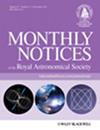第一批恒星在白矮星光度函数暗端留下的印记
IF 4.8
3区 物理与天体物理
Q1 ASTRONOMY & ASTROPHYSICS
引用次数: 0
摘要
种群III恒星的特点是金属性极低,因为它们被认为是由宇宙早期的原始气体形成的。虽然种群 III 恒星的存在已被广泛接受,但由于缺乏直接的观测证据,阻碍了对这些假定恒星性质的研究。在本文中,我们探讨了利用最古老恒星的残余物--白矮星的光度函数来制约其性质的可能性。我们利用半解析模型 a-sloth 跟踪类银河系中恒星的形成,研究白矮星群的形成和演化。我们通过应用线性初始-最终质量关系和梅斯特尔冷却模型得出了白矮星的光度函数。得到的光度函数与现有的观测数据和理论预测基本一致--Mabs = 16 时呈指数增长,达到最大值,而在 Mabs > 16 时则突然下降。我们探讨了模型的不确定性,并将其与观测估计值进行了比较。我们采用了两种不同的种群III恒星初始质量函数模型,以证明光度函数的暗端印有种群III残余的特征。如果在未来的观测中探测到这一特征,它将为种群III恒星提供线索,同时也是低质量到中等质量种群III恒星的间接证据。我们将讨论探测该特征所面临的挑战和前景。本文章由计算机程序翻译,如有差异,请以英文原文为准。
The imprint of the first stars on the faint end of the white dwarf luminosity function
Population III stars are characterized by extremely low metallicities as they are thought to be formed from a pristine gas in the early Universe. Although the existence of Population III stars is widely accepted, the lack of direct observational evidence hampers the study of the nature of the putative stars. In this article, we explore the possibilities of constraining the nature of the oldest stars by using the luminosity function of their remnants – white dwarfs. We study the formation and evolution of white dwarf populations by following star formation in a Milky Way-like galaxy using the semi-analytic model a-sloth. We derive the white dwarf luminosity function by applying a linear Initial-Final Mass Relation and Mestel’s cooling model. The obtained luminosity function is generally in agreement with available observations and theoretical predictions – with an exponential increase to a maximum of Mabs = 16 and a sudden drop for Mabs > 16. We explore the uncertainties of our model and compare them to the observational estimates. We adopt two different models of the initial mass function of Population III stars to show that the faint end of the luminosity function imprints the signature of Population III remnants. If the feature is detected in future observations, it would provide a clue to Population III stars and would also be an indirect evidence of low- to intermediate-mass Population III stars. We discuss the challenges and prospects for detecting the signatures.
求助全文
通过发布文献求助,成功后即可免费获取论文全文。
去求助
来源期刊

Monthly Notices of the Royal Astronomical Society
ASTRONOMY & ASTROPHYSICS-
CiteScore
9.10
自引率
37.50%
发文量
3198
审稿时长
3 months
期刊介绍:
Monthly Notices of the Royal Astronomical Society is one of the world''s leading primary research journals in astronomy and astrophysics, as well as one of the longest established. It publishes the results of original research in positional and dynamical astronomy, astrophysics, radio astronomy, cosmology, space research and the design of astronomical instruments.
 求助内容:
求助内容: 应助结果提醒方式:
应助结果提醒方式:


